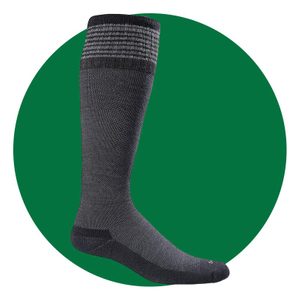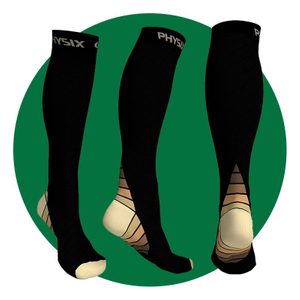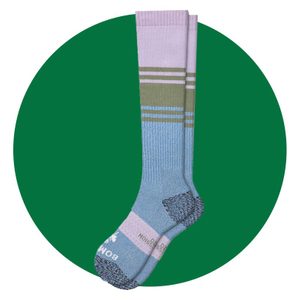You may have heard of compression socks, and may have even been advised to wear them by your doctor or a friend. But what are they? And what do they do? Compression socks can be incredibly effective at preventing a myriad of side effects and even health conditions. These long stockings apply low or high graduated pressure to your legs in order to improve blood flow to your lower extremities, explains Janessie Mena, physical therapist at USA Sports Medicine. They come in a variety of sizes and pressure levels depending on a person’s specific needs.
(Related:7 Amazing Canadian Yoga Wear Brands (That Aren’t Lululemon))
What do compression socks do?
People wear compression socks for all sorts of reasons, but the most common is to help promote blood flow of the veins in the legs, according to Jordan Duncan, a chiropractor at Silverdale Sport & Spine in Silverdale, Washington. “Veins don’t have blood pressure, so they rely on muscular contraction to move blood back to the heart,” he says. “They also have valves that prevent blood from pooling but these sometimes don’t work as well as they should, which can lead to blood pooling in the lower legs.”
Compression socks can help prevent this blood from pooling and can increase the circulation of lower leg veins.
Who should wear compression socks?
There are plenty of reasons to don compression socks, but these groups can benefit the most, says Niket Sonpal, MD, a New York City-based internist and gastroenterologist and faculty member Touro College of Medicine:
- people at risk for circulation issues (diabetes, varicose veins, deep vein thrombosis)
- people who stand on their feet all day
- people who’ve recently had surgery
- people confined to bed rest
- pregnant women
- people on long flights
- athletes
“These individuals can particularly benefit because the socks can prevent legs from getting achy and tired, reduce swelling, and improve oxygen delivery and blood flow,” he adds.
(Related:Whats the Best Exercise for High Blood Pressure?)
What are the different types of compression socks
There are several different types of compression socks, and each caters to different needs. Here is a look at some of the main types:
Graduated compression socks: Graduated compression socks have the greatest amount of compression at the ankle, according to Dr. Duncan, which decreases the higher up the sock you get. “This type of compression sock is designed for the ambulatory population and is used in the treatment of chronic vein disorders and edema,” he says.
Anti-embolism compression socks: Anti-embolism socks are most beneficial to those who are confined to bed or who are not mobile, according to Dr. Sonpal.
“Those who are recovering after an operation can also benefit from anti-embolism compression socks because they are at higher risk of developing DVT,” he says. “Anti-embolism compression stockings reduce the chances of DVT.”
It’s worth noting, however, that this type of compression socks usually require a doctor’s prescription.
How do you wear compression socks?
Compression socks are meant to be tight around your foot, ankle, and calf, so they can be a bit tricky to get on.
One of Mena’s favorite tricks is cutting open the bottom of a plastic bag (like a grocery bag), putting your foot through first, and then applying the compression sock right over it in order to help it slide up your leg easily. Last, pull the bag out of the sock and tear it to completely take it off. If you don’t want to cut the bag, you can fold it vertically and place part of the bag between your first and second toe, then pull the sock up, and pull the bag out,” she says.
“Talcum powder or cornstarch is also an option to apply around your foot or ankle to make it easier for the sock to slide up,” Mena adds.
(Related:6 Ways to Reduce Pain in Your Feet, Legs and Back)
Qualities to look for in a compression sock
Here are the features that experts recommend looking for when shopping for a compression sock.
Length: When shopping for compression socks, it’s important to make sure that the pair you’re buying is the appropriate length in order to meet your needs. “For example, if you are someone that typically has swelling in your ankle, then you want to buy a sock that at least goes up to your knee,” says Mena. “You also want to make sure they’re not too long in order to avoid them rolling down your leg or bunching up.”
Pressure level: The amount of pressure the sock has is another top consideration. “If you’re looking for a sock with mild compression, then you want to look for one that is between 8-15 mmHgmedium would be 15-20 mmHg, and firm is 20-30 mmHg,” says Mena. If you’re not sure which amount of pressure is best for you, consult with your healthcare provider.
Quality: “Cheap compression socks have limited sizing options, and if you end up with the wrong size, swelling can worsen,” warns Dr. Sonpal. He recommends investing in higher-priced compression socks, as these will get you the best fit possible.
The best compression socks to reduce swelling
Here are the compression socks that are top-recommended by experts to help reduce swelling and achy legs.
(Related:6 of the Best Leggings for Exercising Indoors)

Sockwell Elevation Graduated Compression Socks
If you’re looking for a pair of compression socks for all-day wear, regardless of whether you’ll be sitting, standing, or walking around the majority of the day, Dr. Duncan recommends this pair, which can also be worn for exercise.
“The graduated compression design of these socks promotes circulation by pushing blood up towards the heart,” he says. “These socks have a snug fit that helps prevent them from slipping in your shoe.”
$85, walmart.ca.
(Related:7 Silent Blood Clot Symptoms to Watch Out For)

Physix Gear Compression Socks
For athletes, it is important that the compression sock be snug, but not cut off circulation, notes Mena. She recommends Physix Gear Compression Socks to her athlete clients as well as anyone who will be on their feet for the majority of the day during the week. They’re made from a high-quality fabric that doesn’t pinch in any place. They’re also very breathable, which comes in handy on a hot day or during a workout.
$43, walmart.ca.
(Related:9 Benefits of Stretching That Will Convince You to Do It Daily)

Bombas Women’s Compression Socks
This pair of medium-strength compression socks for women provides 15-20 mmHg of compression and comes in seven colors and three sizes (S, M, and L). Notable features include extra durable double yarn, a seamless toe and the classic Bombas honeycomb arch support system for maximum comfort, and even strategic zone cushioning. They’re an ideal option for those who want to workout travel, are pregnant, or want some extra support without going higher than 15-20 mmHg.”Perfect compression for me. These are much easier to put on than the 20-30 compression. Glad I got 2 pairs,” writes one reviewer.US$24, bombas.com.Next, here are the best sports bras for bigger busts in Canada.
The post How to Know If Compression Socks Will Benefit You (Plus 3 to Buy in Canada) appeared first on Best Health Magazine Canada.


0 Commentaires